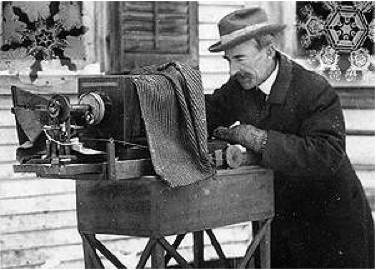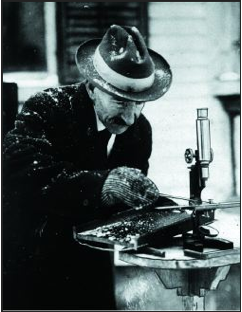Snowflake Bentley
“Under the microscope, I found that snowflakes were miracles of beauty; and it seemed a shame that this beauty should not be seen and appreciated by others. Every crystal was a masterpiece of design and no one design was ever repeated. When a snowflake melted, that design was forever lost. Just that much beauty was gone, without leaving any record behind.”
--Wilson "Snowflake" Bentley 1925
(Mullet, 1925)
(Mullet, 1925)
About William A Bentley (1865-1931):
http://www.youtube.com/watch?v=ptLmA263hlk 1:35
Bentley was born on a homestead in Jericho, Vermont, near the base of Bolton Mountain. His mother was a school teacher, but Bentley did not start school until age 14, prior to that he was taught at home by his mother. At age 15 Bentley’s mother gave him a small microscope, which ended up shaping the rest of his life (Blanchard, 1970).
 From the moment Bentley received the microscope, he looked at everything he could, including snowflakes. He loved to focus his microscope on individual snowflake crystals and makes sketches of what he saw. However, often times he could
From the moment Bentley received the microscope, he looked at everything he could, including snowflakes. He loved to focus his microscope on individual snowflake crystals and makes sketches of what he saw. However, often times he could not sketch fast enough and the snowflake would melt. Furthermore, he did not think that the sketches were doing the snowflakes justice.
For a year Bentley experimented with his camera, his microscope, and dry plates. He was attempting to take pictures of snowflakes, and finally on January 15, 1885, he successfully captured an ice crystal (Blanchard, 1970).
The Process:
Location:
This may go without saying, but to take a picture of ice crystals, it needs to be snowing and the temperature must be below freezing.
Materials:
The bellows of the camera allows extension up to three feet. The snowflake, which is on a typical rectangular microscope slide, is place under the microscope, which has been attached to the front of the camera (Mullet, 1925).
The microscope is “fitted with a joint that permits the instrument to be turned down horizontally, at right angles to its base, so that it can be coupled to a camera bellows by means of a light-tight connection. The microscope objectives are used alone, without the eyepiece” (Bentley, 1922).
Snowflake Gathering:
Using the blackboard with the handles, one catches snowflakes as they fall. Using the naked eye, or a hand magnifying glass, snowflakes are inspected.
The feather or similar style duster is used to brush away the unwanted snowflakes until all that remains are the snowflakes for photographing (Bentley, 1922).
Placing the ice crystal on the microscope slide:
“The removal of the snowflake from the board to the microscope slide is accomplished with the sharp-pointed splint, which is pressed gently against the face of the crystal until the latter adheres to it,
so that it can be picked up and placed on the glass slide” (Bentley, 1922).
This may go without saying, but to take a picture of ice crystals, it needs to be snowing and the temperature must be below freezing.
- warm snow gear for the photographer
- observation microscope
- glass microscope slides
- feather or similar duster
- sharp splint
- an extra focusing back for the camera, containing clear glass instead of the usual ground glass, with a magnifying lens attached; this is used for final focusing
- A blackboard with handles at the end so that the heat of your hand will not warm up and melt the snowflakes
- “As it is necessary to cover the end of the microscope objective with a strip of black card, that takes the place of the usual camera shutter which controls the duration of exposure, it is necessary to fit two vertical rods at each side of the microscope tube to hold the card” (Bentley, 1922).
The bellows of the camera allows extension up to three feet. The snowflake, which is on a typical rectangular microscope slide, is place under the microscope, which has been attached to the front of the camera (Mullet, 1925).
The microscope is “fitted with a joint that permits the instrument to be turned down horizontally, at right angles to its base, so that it can be coupled to a camera bellows by means of a light-tight connection. The microscope objectives are used alone, without the eyepiece” (Bentley, 1922).
Using the blackboard with the handles, one catches snowflakes as they fall. Using the naked eye, or a hand magnifying glass, snowflakes are inspected.
The feather or similar style duster is used to brush away the unwanted snowflakes until all that remains are the snowflakes for photographing (Bentley, 1922).
“The removal of the snowflake from the board to the microscope slide is accomplished with the sharp-pointed splint, which is pressed gently against the face of the crystal until the latter adheres to it,
so that it can be picked up and placed on the glass slide” (Bentley, 1922).
Snapping the Photograph-Front End of the Camera:
http://i.telegraph.co.uk/multimedia/archive/01563/wilson-bentley_1563452i.jpg
- specific snowflakes are put flat on the glass slide using the feather
- insert glass slide on the microscope at the front of the camera
- “The plate holder is then inserted into the camera, the objective covered with the black card and the slide removed from the plate holder” (Bentley, 1922)
- “The objective is then uncovered, and when the exposure, which may vary from 8 seconds to 100 or more, is deemed sufficient, the operation is reversed. Naturally enough, no rule for the length of exposure can be given, except that the greater the magnification, the longer the exposure should be” (Bentley, 1922).
- The bellows long extension makes it hard to reach the focusing screw on the microscope
- Problem can be solved by creating “a cord that runs over a wheel on each side of the camera and around the focusing screw” (Bentley, 1922).
- “No lens is required in the camera, the microscope furnishing the optical equipment for projecting the images onto the sensitized plates” (Bentley, 1922).
Photographic Negative:
- Snowflake image is recorded on the photographic negative and brought out through development
- Image is very transparent, which makes it hard to be seen when printed
- “There is no purely photographic method for producing the white images against a dark background, and yet it is necessary to do so if the images are to be appreciated by most people, whose ideal of snow is that of immaculate whiteness. The only effective method of accomplishing this result is what is known among photographers as "blocking out” (Bentley, 1922).
- “The negative is supported on an ordinary retoucher's desk, which may be merely a piece of glass, arranged to hold the negative so that the image is illuminated by transmitted light. Then, with an etching knife or other fine, sharp-pointed tool, the operator proceeds to scrape away the emulsion around the outline of the crystal to leave it standing alone against a background of clear glass” (Bentley, 1922).
- To prevent harm to the original negative, Bentley suggests to not alter it, but to make a copy of the negative to use for blocking out.
- After the negative is prepared, one can make prints or slides in the usual manner.
- The blocking out process can and should be conducted indoors
Over his career, Bentley captured more than 5,000 snowflake crystals and no two were the same.
Interesting To Think About:
What I find the most interesting about Bentley is his timing and dedication. Niépce took "View from the Window at Le Gras" in 1826 and the exposure took 8 hours. Only 60 years later Bentley was able to take microscopic captures of snowflake crystals in minutes. It boggles my mind. Also, he was a pioneer. No one had ever thought of taking photos of snowflake crystals before, and through trial and error he was able to find a way to capture this beauty in a way that no one has done since.
Interesting To Think About:
What I find the most interesting about Bentley is his timing and dedication. Niépce took "View from the Window at Le Gras" in 1826 and the exposure took 8 hours. Only 60 years later Bentley was able to take microscopic captures of snowflake crystals in minutes. It boggles my mind. Also, he was a pioneer. No one had ever thought of taking photos of snowflake crystals before, and through trial and error he was able to find a way to capture this beauty in a way that no one has done since.
References:
Bentley, W.A. (1922). Photographing Snowflakes. Popular Mechanics Magazine, 37, 309-312. Retrieved from http://snowflakebentley.com/WBpopmech.htm
Blanchard, D.C. (1970). The Snowflake Man. Weatherwise, 23 (6), 260-269.
Retrieved from http://snowflakebentley.com/WBsfman.htm
Mullet, M.B. (1925). The Snowflake Man. The American Magazine, February.
Retrieved from http://snowflakebentley.com/WBmullet.htm
Images, in order:






No comments:
Post a Comment